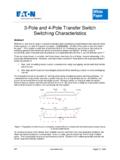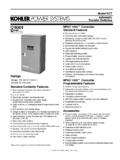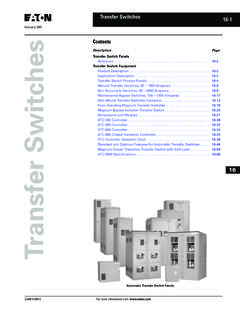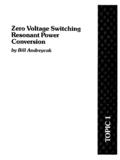Transcription of White Paper WP140001EN Transfer switch 101 - Eaton
1 Transfer switch 101An introductory guide to picking the right Transfer switch for your environmentCharlie Hume Product Line Sales Engineer, Automatic Transfer Switches EatonExecutive summaryTransfer switches play an essential role in keeping critical electrical loads functional during power outages. In an effort to help facilities managers and others select the most appropriate Transfer switch for their specific environment, this White Paper introduces readers to what Transfer switches do and describes their most common applications, transition types, switching mechanisms, and operation of contentsTransfer switch basics ..2 Common system installation types.
2 2 Emergency systems ..2 Legally required systems ..2 Critical operations power systems (COPS) ..2 Optional standby systems ..2 Understanding transition types ..2 Open transition ..2 Closed transition ..3 Understanding switching mechanisms ..4 Contactor switching mechanisms ..4 Molded case switching mechanisms ..4 Power case switching mechanisms ..5 Understanding operation modes ..5 Manual mode ..5 Non-automatic mode ..5 Automatic mode ..6 Bypass isolation mode ..6 Conclusion ..6 About Eaton ..6 About the author ..6 White Paper WP140001 ENEffective March 20152 Transfer switch 101 Eaton Paper WP140001EN Effective March 2015 Transfer switch basicsData centers, hospitals, factories, and a wide range of other commercial and institutional facilities that require continuous or near-continuous uptime typically utilize an emergency power source, such as a generator or a backup utility feed, when their normal power source is unavailable.
3 Transfer switches are responsible for quickly and safely transitioning all electrical power consumed by the circuit, equipment, or systems connected to the Transfer switch output between those normal and emergency power sources. All electrical power consumed by the circuit, equipment, or system connected to the Transfer switch output is defined as the load. A typical Transfer sequence includes these normal power source power from the generator or the backup utility feedis stable and within prescribed voltage and frequencytolerances, the Transfer switch shifts the electrical load to theemergency power source. Depending on the facility s needsand preferences, that Transfer either occurs automatically or isexecuted utility power is restored, the Transfer switch returns theload from the emergency power source to the normal , this can happen automatically or manually, depending onthe type of switch being used and its operation 1.
4 One-line drawing of the basic elements of a Transfer switch Common system installation typesTransfer switches are employed in a variety of applications that typically fall into one of four categories defined by the National Electrical Code (NFPA 70): emergency systems, legally required systems, critical operations power systems, and optional standby systems. Understanding those categories is important, as they play a critical role in determining what kind of Transfer switch you require. Emergency systemsEmergency systems supply, automatically distribute, and control electricity used by systems essential to life safety during fires and other disasters.
5 They include fire detectors, alarms, emergency lights, elevators, fire pumps, public safety communication systems, and ventilation systems, and are commonly found in hotels, theaters, sports arenas, and systems are regulated by a municipal, state, federal, or other government agency. Transfer from the normal power source to the emergency source must complete within 10 seconds and meet the requirements of Article 700 of the National Electrical Code (NFPA 70). In addition, overcurrent devices must be selectively coordinated with all supply-side overcurrent protective devices. Legally required systemsLegally required systems automatically supply power to a selected set of regulated loads not classified as emergency systems when normal power is unavailable.
6 They serve critical heating, refrigeration, communication, ventilation, smoke removal, sewage disposal, and lighting functions that could create hazards or hamper rescue or fire-fighting operations if denied electrical power. As with emergency systems, legally required systems are regulated by municipal, state, federal, and other governmental agencies. Transfer from the normal power source to the emergency source must complete within 60 seconds and meet the requirements of Article 701 of the National Electrical Code (NFPA 70). Overcurrent devices must be selectively coordinated with all supply-side overcurrent protective devices. Critical operations power systems (COPS)COPS supply, distribute, and control electricity in designated critical areas when a normal power source fails.
7 They include HVAC, fire alarm, security, communication, signaling, and other services in facilities that a government agency has deemed important to national security, the economy, or public health and safety. All COPS must meet the requirements of Article 708 of the National Electrical Code (NFPA 70), and their overcurrent devices must be selectively coordinated with all supply-side overcurrent protective devices. Optional standby systemsOptional standby systems supply power to loads with no direct bearing on health or life safety, and are not required to function automatically during power failures. They are typically found in commercial buildings, farms, and even residences, and must meet the requirements of Article 702 of the National Electrical Code (NFPA 70).
8 Understanding transition typesTransfer switches can transition loads between normal and emergency power sources in two basic ways: open or closed. The specific functions performed by a given load and the importance of those functions to safety or security play an important role in determining which kind of transition is required. Open transitionAn open transition is a break before make Transfer . That is, the Transfer switch breaks its connection to one power source before making a connection to the other. For some period of time between disconnection and connection, neither the normal power source nor the emergency source is providing electricity to downstream loads.
9 There are two kinds of open transition: open delayed and open switch 101 Eaton Paper WP140001EN Effective March 2015 Open delayed transitionIn an open delayed transition, the Transfer switch pauses in-between disconnecting from one power source and connecting to the other. That delay typically lasts either a specific, pre-set amount of time or however long it takes the load voltage to drop below a pre-specified Building a delay into the transition process can prevent higherthan normal electrical current (also known as inrush current )from developing. Inrush current can occur when an inductiveload is rapidly reconnected to a non-synchronized power can be an issue in applications where a residual voltage isbriefly maintained at the load due to the generator effect createdby a rotating motor or by the stored energy released from atransformer s windings or core Operation is independent of electrical synchronization betweenboth sources of power A Transfer between power sources can be initiated automaticallyor manuallyDisadvantages Unless some type of stored energy system, such as anuninterruptible power supply (UPS)
10 , is located downstreamof the Transfer switch , loads will experience a brief interruptionin power during the transition delay periodOpen in-phase transitionWith open in-phase transitions, an automatic controller uses built-in intelligence to execute an open transition at the precise moment it expects the normal and emergency power sources to be synchronized in phase, voltage, and frequency. In-phase transitions are typically completed in 150 milliseconds or less to ensure that inrush current is equal to or less than the normal starting current of the inductive load(s). If synchronization doesn t occur within that time span, some Transfer switches have the ability to default automatically to a delayed transition that serves as a The rapid Transfer time means that a Transfer is accomplishedwithout an appreciable power interruption to the load, providedthat the system is properly adjustedDisadvantages In-phase transitions must be executed by an automatic operation is not possible as microprocessor logic isneeded to manage source synchronization If both sources of power are available but unable to meet pre-setsynchronization criteria, and the Transfer switch isn t capable ofdefaulting to a delayed transition.

















